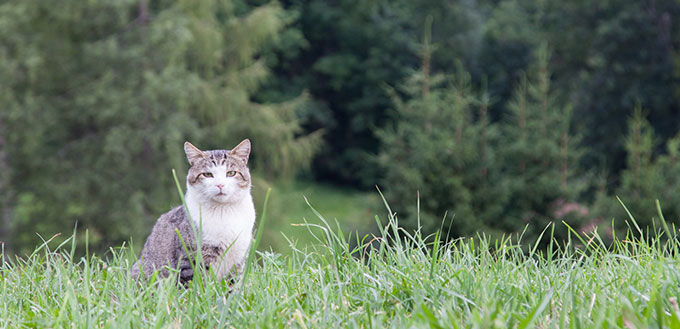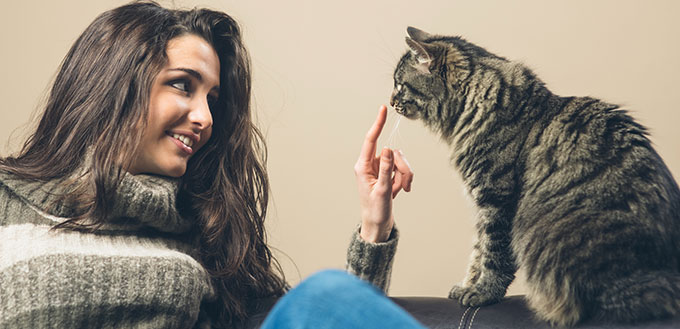It might seem like an odd question, but it’s certainly one that crops up from time-to-time. And, while we know that cats are mammals – and all mammals gestate with a placenta – it can still be hard to wrap your head around whether or not there is such a thing as a cat belly button. Of course, it’s not unheard of for cats to have a problem with belly strokes, so locating one can be considered all the more difficult.
In this article, we’ll be talking about all things belly button, answering those burning questions such as “do cats have umbilical cords?” and “do cats have belly buttons”. Better still, we’ll give you a quick biology lesson, so you can get to know the ins and outs of those innies and outies.
What is an Umbilical Cord?
The belly button – also known in the scientific world as the umbilicus – is a small entryway in the fetus of mammals. Here, the umbilical cord is able to grant access to all of the essential organs and allows nutrient-rich blood to pass from mum to baby. Filled with veins and arteries, the umbilical cord has a tough outer lining to protect it from damage during both pregnancy and birth – basically, until the fetus becomes a baby and can breathe for itself.
The umbilical cord is attached to the placenta, which works as a filtering system for blood from the mother. The placenta uses incredible, natural engineering in order to allow for oxygen, antibodies and essential nutrients to pass to the fetus, while blocking out the bad bacteria present in blood.
Do Cats Have an Umbilical Cord?
Absolutely. In cats, there is often more than one kitten present in the womb – which means there are lots of cords and placenta to consider during birth. Because oxygenated blood comes from the mum, it means there is a very high level of pressure placed on her heart during pregnancy, especially with so many placentae to cater to.
Luckily, the umbilical cord is short enough that they don’t become tangled together, and kittens are able to stay close to the placenta – this also shortens the journey of the blood, giving mum a bit of a break!
Should I Remove the Umbilical Cord from a Kitten?
Like all mammals, once the baby, kitten, puppy or any other young has been born, the baby is able to breathe in their own oxygen and, therefore, the cord and placentae are no longer needed. Shortly after birth, the cord spasms and will separate from the placenta, leaving a short part behind.
If you’ve recently had kittens are wondering whether to remove the rest of the umbilical cord, or whether the remaining cord is causing any pain, fear not. Once the umbilical cord is separated from the placenta, it is left on the kitten until it dries, shrivels and falls off of its own accord. And, while it may not be particularly pleasant to look at, it is best to avoid interfering with the healing process and there may still be some essential nutrients within the cords that have not yet been fully absorbed.
Allowing the cord to drop off of it’s own accord also means that you are less likely to open up a wound, which then has a greater chance of infection. Thus, the only reason you should ever alter the remaining cord, is if the area looks as though it could be infection – and, even then, this should only be done to clean the wound after taking advice from your vet. Remember that kittens do not yet have an immune system, so even the laziest bacteria can cause serious harm to your young cats.
Do Cats Have Belly Buttons?
Once the umbilicus has fallen from the stomach of your kitten, you will notice a small scar left behind. Congratulations, you have just found the belly button! Don’t worry, just like humans, this scar will remain for the rest of their life but not cause any harm or damage. In young kittens, there is an increased risk of infections if the scar is removed, however, so try to discourage any young from licking their own – or each other’s – bellies.
Where Can I Find my Cat’s Belly Button?
Finding a belly button on a fully-grown cat can be a lot more difficult than it might be on a human. For starters, it’s in a different area of their stomach, so initial hunts can prove disappointing. Secondly, you have all that fur to compete with! Then there’s the fact that many cats do not approve of hunts relating to their bellies – indeed, some don’t even enjoy a stroke in that area and long periods of time spent around there can often result in a shredded hand. Finally, the heavier your cat, the harder it can be to find the belly button, as the excess fat can stretch the scar and make it thinner – and therefore harder to find.
The best time to find the belly button on your cat is when they are completely comfortable and relaxed around you. In these cases, a cat may often roll over to show you their stomach in an effort to display their familiarity and trust toward you. However, don’t take advantage of this for too long and never try to stroke an unfamiliar cat who is rolling around – it could simply be that they are playing!
Most cats have a relatively high belly button, when compared to humans, and you can find their naval just below the rib cage. Bear in mind that it will be very small – roughly 5mm long – so, if you can’t spot it, don’t try to move the fur around too much. Simply try again another time – or check out Google, to see one without any risk, at all!
Does My Cat Have an Innie or an Outie?
This is the main difference between cats and humans, and the reason so many people seem to be under the impression that cats may not have belly buttons. While humans have what is typically referred to as “innies” or “outies” (fun fact: roughly 90% of humans have innies, and only 10% have outies) cat belly buttons don’t really take on the “button” form. A cats naval is more of a flat thin scar that marks where the umbilical cord was once attached.
When is a Belly Button Not a Belly Button?
If you are checking on a young cat or kitten to see how their belly button is forming, and they appear to have an “outie”, it could be that this is, in fact, a hernia. Referred to by vets and professionals as the umbilical hernia, this occurs when the umbilical cord has not quite healed properly.
The result is a small opening in the abdominal wall, creating a soft pouch which bulges slightly where the scar is usually based, creating the appearance of an outie. While this sounds rather serious, most umbilical hernias are capable of healing up of their own accord, so try not to stress too much. However, they are more prone to infections and the hernia can worsen over time – especially when the kitten is undertaking a lot of physical exertion.
As a general rule, if the hernia does not close up and become the traditional belly button or scar by the time they are ready to undergo spaying or neutering, which is roughly between 3 and 4 months old. In these cases, it can worth having the vet close up the hernia, while the kitten is already undergoing surgery. Doing so causes less stress than having to handle two surgeries at a young age, and gives the hernia a chance to heal of it’s own accord.
Untreated hernias can cause life-threatening illnesses if they are not surgically repaired after this time, so do keep an eye on these. And, as always, do contact your vet if – at any time – you are concerned about the healing of belly buttons in kittens, or if you’re concerned about your adult cats belly button.
You may also like our review of the best kitten food.
Note: The advice provided in this post is intended for informational purposes and does not constitute medical advice regarding pets. For an accurate diagnosis of your pet's condition, please make an appointment with your vet.









